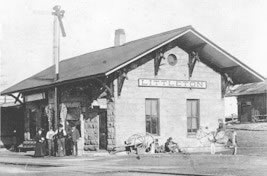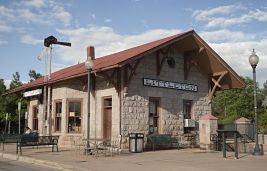Denver & Rio Grande Railroad Depot
Local Designation—1973

The Denver & Rio Grande Railroad Depot, c.1907.
The first railroad to reach present-day Littleton was the Denver & Rio Grande on October 28, 1871. The line was being built by William Jackson Palmer to connect Denver to the resort community he had just founded, Colorado Springs. Richard Little's farm just happened to be along the way. The relatively cheap, quick and reliable transportation it provided, though, was just the ticket to expanding markets for Little's Rough and Ready Flour Mill and the assurance of Littleton's prosperity.
The original stone depot measured 48 feet long and 24 feet wide, and was constructed with rough cut (quarry cut) Castle Rock rhyolite, a very popular building stone in late 19th century Colorado, and set with beaded mortar joints. The building is divided in to three rooms, one larger and two smaller. The gabled roof has deep overhanging eaves supported by timber brackets decorated with acorn shaped finials. On each of the gabled ends is a round window, which was probably added more for aesthetics than for function. The main entrance is a large paneled door with two paneled and glass sidelights with a transom window above the door. Most of the windows are double hung with divided lights (muntins). Some of the windows have stone pediment lintels. The second entrance is a paneled door with a stone pediment lintel. Next to the Littleton sign is the original signal tower.

The Denver & Rio Grande Railroad Depot, 2015. Photo by Amelia Martinez.
Regular service began on January 1, 1872, and after a year as a flag stop, the railroad built a wood-frame depot in 1873. Two years later this was replaced by the stone depot that residents know today. By this time a second railroad passed through Littleton on the west side of the South Platte River. The Denver, South Park and Pacific railroad connected Denver with the mining district of Leadville. In 1887 the Atchison, Topeka and Santa Fe added its own rails, encouraging even greater growth in local manufacturing. The heyday of railroading in Littleton began in 1889 when the D&RG initiated regular commuter service between Littleton and Denver. Dubbed the "Uncle Sam", because it also served the newly opened army post at Fort Logan, up to six trips per day helped turn Littleton from a quiet farming community into a bedroom suburb of Denver. Trolleys, automobiles and buses began reducing the reliance on rail service soon after the turn of the century, and passenger service to Littleton discontinued in 1967. The depot still handled freight until 1982, when that too stopped, and the depot closed to the public.
Over the years, various alterations and additions were made to the depot, including: construction of bay windows and a separate baggage room to the north in 1906; the 1942 enclosure of the area between the buildings and addition of a two-lavatory lean-to on the east side; painting of the exterior, remodeling of the interior and changes to many of the windows and doors.
In 1973, the depot was designated a "Landmark" by the City of Littleton, and in 1979, the State declared it eligible for listing in the National Register of Historic Places. After it ceased operation, it became threatened with destruction by the "Littleton Railroad Depression", a public works project designed to lower the railroad tracks into a huge trench, thereby alleviating automobile congestion in downtown Littleton. In 1984 the depot was moved to Crestline Avenue and Rio Grande Street, about one-half mile from its original location, and renovated at a cost of about $40,000. All of the exterior additions were removed, including the white paint from the beautiful and naturally colored rhyolite, while interior details were restored, including door locks which use skeleton keys. The depot was moved a second time in 2000 to the Regional Transportation District's light rail station on Prince St. in downtown Littleton; it was used as a coffee shop, Romancing the Bean, from 2000 until 2020 when the shop closed. In April 2021 the Littleton City Council approved an agreement between the City and Garett Palecek of Curds Cheese to open a new coffee shop in the depot. The coffee shop, Nook Coffee, opened in 2022.
The D&RG Railroad Depot is architecturally significant, in that it is one of only a few remaining examples of the 19th century style of small, stone depots. Its historic significance to the Littleton area is undeniable, and represents the important role that railroads played in the development of Littleton and the West, in general.
More photos »
Bibliography
Littleton Independent. Littleton Independent Publishers, 1888- .
Littleton Museum. Photographic Archives.
____. Vertical File: "Denver & Rio Grande Depot".
Lobato, Rudolph. An Architectural and Historical Building Survey: Inventory and Evaluation, Littleton, Colorado. Littleton: Littleton Area Historical Museum, 1972.
McQuarie, Robert J. and C.W. Buchholtz. Littleton, Colorado: Settlement to Centennial. Littleton: Littleton Historical Museum and Friends of the Library and Museum, 1990.
Inventory Sources:
Wilkins, Tivis. "Colorado Railroads" (Boulder: Pruett Publishing Co., 1974)
Littleton Historical Museum Files
Colorado Historical Society, Office of Archeology and Historic Preservation Files
McQuarie, Robert and Bucholtz, C.W., "Littleton From Settlement to Centennial: (Littleton:
Littleton Historical Museum)
Rocky Mountain News, 10 April 1983 and 3 December 1989
Noel, Thomas J. "Buildings of Colorado" (New York: Oxford University Press, 1997)
Waring, Houstoun, "Hous's Littleton", (Littleton: Littleton Independent, 1981)
Photographs courtesy of the Littleton Museum unless otherwise noted. To order copies, contact the museum at 303-795-3950.
Compiled by Pat Massengill
Edited by Kris Christensen, Colorado Digitization Project
Updated March 2022 by Phyllis Larison